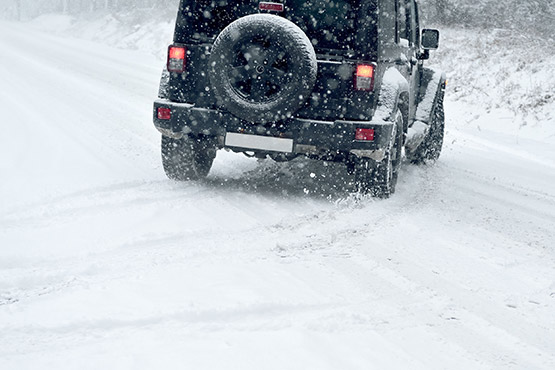Winter Driving Tips To Reduce Auto Accidents
Winter weather and driving conditions are facing us now, and drivers need to mentally AND physically prepare themselves for hazardous road conditions. The leading cause of death during winter storms is transportation accidents. Preparing your vehicle for the winter season and knowing how to react if you become stranded or lost on the road are the keys to safe winter driving. The following are some general ideas to help keep you safe:
- Slow down! The major cause of accidents during the winter is drivers going too fast or using their brakes aggressively. Drive according to road and weather conditions. Remember, the posted speed limits are for dry pavement and good weather conditions The faster your vehicle is going, the more distance it will take to turn, slow, or stop.
- Don't get overconfident with four or all-wheel drive vehicles. Four-wheel drive helps you get going quicker but it won't help you stop any faster. If you have it, use it...but if you use it, slow down. The most commonly heard comment at winter accidents is, “...but Officer, I had it in four-wheel-drive!”
- Leave plenty of room for stopping, brake early and look further ahead in traffic.It takes more time to stop when roads are wet or icy; actions by other drivers may alert you to problems and give you extra seconds to react. Bridge decks will ice up first, even when the rest of the road seems to be in good condition.
-
Don't use your cruise control or overdrive when it's freezing (or colder). Even roads that appear clear can have isolated slippery spots...”black ice” is invisible. The short touch of your brakes to deactivate cruise control can cause you to lose control of your vehicle. With overdrive, as you encounter a hill, your vehicle automatically accelerates or downshifts, which can cause loss of traction; downshift manually.
-
Don't pump anti-lock brakes, and focusing on making everything smooth and controlled. If your car is equipped with anti-lock brakes, do not pump your brakes. The right way is to "stomp and steer"; hold the brake pedal to the floorand steer with smooth, precise movements. Changing lanes too quickly and jerky steering while braking or accelerating can cause skidding.
- Leave room for maintenance vehicles and plows. Stay at least 15 car lengths (200 feet) behind these vehicles and don't pass on the right. Many accidents occur when impatient motorists try to pass a plow or slower vehicle on the right...right through that large plume of snow!
- Be prepared for the unexpected emergency. Always carry a first aid kit, map, ice scraper, snow brush, matches, candles, flashlight, warning triangles, flares, tow and battery jumping cables, a folding shovel, a bag of sand, a blanket, winter gloves, a cell phone if you have one, and an emergency HELP sign that you can put in the back window if you need help.
-
Keep all your car’s windows, mirrors and lights clear of snow and ice. Take an extra minute to clear ALL the snow and ice from your car...not just a little peephole in the front and rear windows. This will also prevent sheets of ice from flying off your car and hitting vehicles following you. Check that headlights, turn signals and brake lights are all visible. Drive with your headlights ON, set on low beam during the day; this turns on the rear tail lights as well, making you more visible from the rear.
- When possible, keep your fuel tank over half-full.If you do get stuck or stranded, your car’s engine will be your only source of heat. Make sure to keep a window cracked if you’re stuck and have the engine running. Keeping the tank at least half-full will also prevent moisture from forming in the empty space during the warmer daytime temperatures. When it cools down at night, that moisture will condense, causing your vehicle to run poorly and eventually rusting out the gas tank.
- Check road and weather conditions BEFORE you leave, even if it is a local trip.Call 511 or go to Trip Check for more detailed information on Oregon road/weather conditions. DO NOT call 911, on either the emergency or non-emergency lines, to inquire about road and weather conditions.



